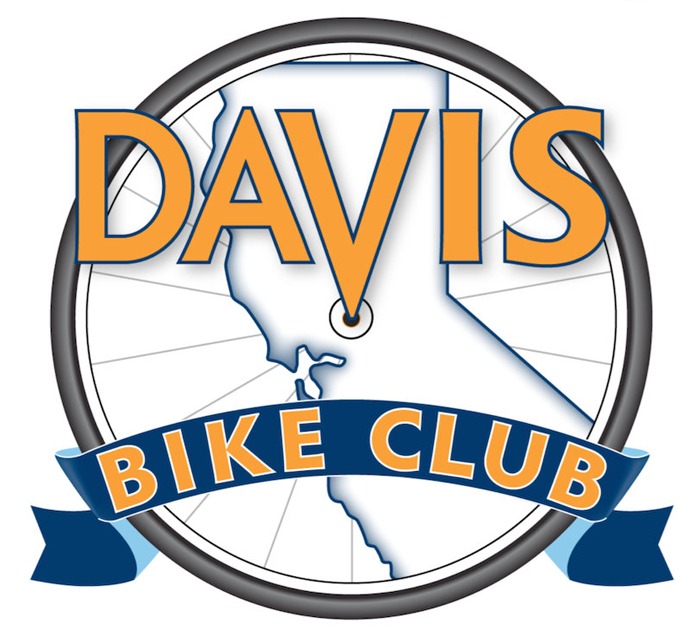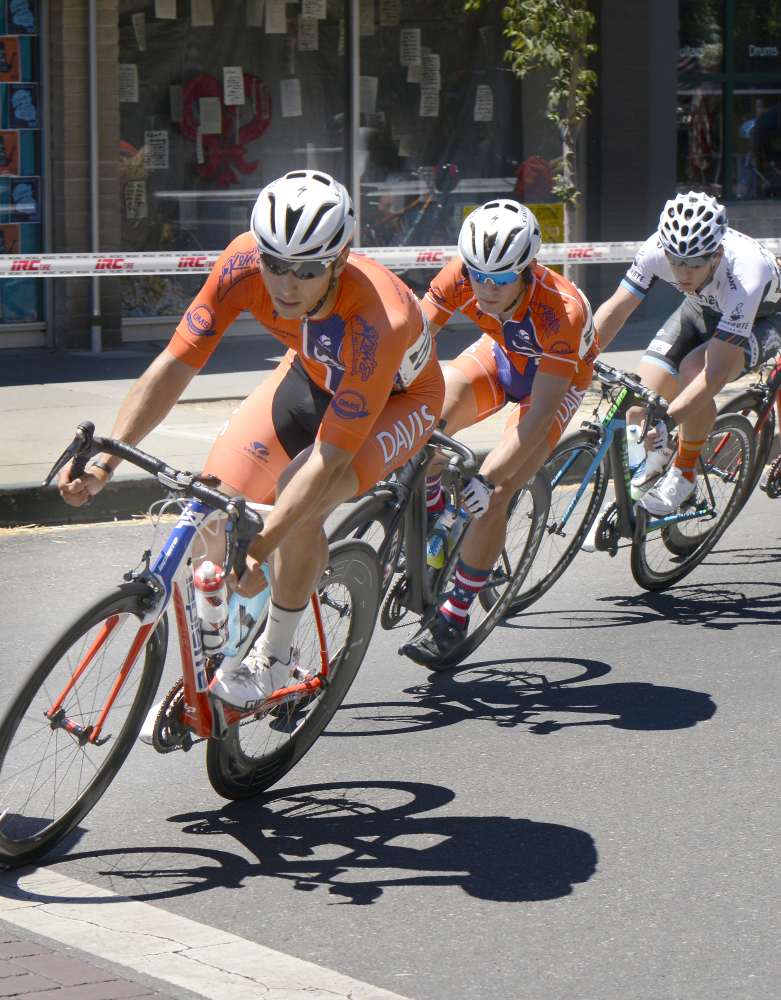Rides often organize into a paceline to save considerable effort when you are in the draft of the riders in front of you. The lead in a paceline will use 30% more power than the riders behind at about 20-25 mph. Usually the faster / longer version of the club rides will ride in a paceline. The more relaxed rides will generally ride more spread out and at a slower pace.
Various club members contributed some helpful paceline riding tips to the DBC list serv and summarized here:
No aerobars in a paceline ride
Aerobars are for time trialing; riding alone on a mostly straight flat course where you have nobody to draft. Bikes with aerobars are not allowed in nearly any organized ride because you don’t have access to brake, shift, and your bike handling ability is compromised. If you are on a group ride, do not use your aerobars in a paceline – if that’s what you have and don’t want to remove them, ride off the back.
Echelon in a cross wind
When you are in the lead of a paceline and there is a crosswind, the leader should line up on the upwind side and the rest of the riders will offset slightly in the downwind direction to form an echelon
- If the wind is blowing from your right, you should ride as far right on the road as you can and those following you will echelon to your left. If the wind is from the left, you need to lead from the left of the lane, as long as that is safe
- Sometimes, however, it’s not always easy to tell if a crosswind is from the left or the right or non-existent, especially when riding near thick orchards. A good clue is if the riders behind you are angled to one side of you or the other. If you are riding on the right of the lane and those following are tailing off to the left, the wind is coming from the right, even if it is not too strong. If the riders behind you are tailing off to your right, the crosswind is from the left. If the cross wind is under a few miles per hour, it really doesn’t matter
Keep the echelon formation tight – Unless your group is five or fewer riders, line up no more than one foot to the side of the person in front of you. If the wind is from your left and you are, say, three feet to the right of the person in front of you, the riders in the back will run out of road to line up, behind and offset from you, and will not benefit from the wind draft. If everyone stays 12 inches or less to the side of the person ahead and each person holds his line on the road, at least 10 people should be able to get a nice draft in an echelon across a traffic lane. If there are are more than 8 in your paceline, it makes sense to form two echelons or form a double paceline
Pull off the lead correctly
When an echelon has formed, you should signal your intent to pull off and then drop back from the trailing riders. (The DBC signal is an elbow wag on the side you expect the person behind you to pass)
- If the others behind your are off to your right, use your right elbow to signal your intent to drop back on the left, then slow down slightly as the others pass you on your right
Maintain a constant speed when taking over the paceline lead. When you are in second position and the lead rider has signaled she wants to fall back, maintain the same speed you had been going when in the second position. When you are now the lead, the wind drag will be higher and you might over compensate to maintain the speed you felt you were going before. If you have a speedometer, watch the speed the paceline is going so you can maintain that pace when you change leads
The previous lead is tired – let her drift back and tuck in the paceline to recover. It is terrible etiquette to accelerate before that rider has made it back in the paceline. If you want to increase the pace from the front position once the last leader is back in the paceline, accelerate slowly – say 1 mph per minute. So you should take two minutes to accelerate from, say, 19 mph to 21 mph
Don’t take the lead too long – Lead for about a minute or so – 1/2 mile and then pull off. Everyone in the paceline will be fresher and more engaged rotating through.
Maintain Your Spacing
Feeling safe when you are drafting in a paceline is mostly about keeping a gap and looking out ahead of the rider in front of you so you can anticipate and react without endangering the riders behind you
- The lead rider and those along the paceline must call out road hazards (hole, rock, stick) as they see them, but it is safest if you can see the problems on your own and react. Remember that you have a team of riders behind you and every action you take impacts them. If a pothole appears out of nowhere, you can stand up on your pedals to shock absorb the impact, and/or bunny hop over it. Practice these skills when you are not in a paceline
- Keep a steady speed in the paceline – Pedal steadily to maintain the pace – modulate your power to keep the line together. If you pedal and coast, pedal and coast, pedal and coast – the spacing of everyone behind you will yo-yo near and far, wasting energy, impacting safety, and annoying everyone behind you. Try to maintain a steady pace. As much as possible, avoid using your brakes in a pace line. And if you
must use your brakes try to make it a light touch. It’s all about taking care of those behind you - Don’t ride too closely. – maintain a gap of 1/2 to 1 1/2 wheel lengths to the wheel in front of you to get full the benefit of the draft. You may see pro races with riders 6-8 inches behind the rider in front of them – they are pros with excellent bike handling and balance skills. Still you see horrendous crashes when there is a wheel touch. You will get the same draft if you are 1/2 – 1 1/2 wheel lengths behind the bike in front of you. If you are attentive to the road and pace, you will not have to jam your brakes if the pace unexpectedly slows, endangering everyone behind you
- Do not overlap wheels and don’t have a large gap either! If you do overlap wheels (pull up ahead of the wheel in front of you) and the person in front moves over to avoid a road hazard, you will almost certainly fall. If you leave a gap of 2+ wheel lengths in front of you, you are not getting much of a draft from the first riders and you and the riders behind you may get dropped. It’s the same problem if the wind is straight ahead and you ride 3-4 feet to the left of the rider in front of you. Offset your wheel left or right 6-9 inches from the wheel in front of you. This gives you a little margin if you are riding close and they slow abruptly
- Don’t fixate on the rear wheel / bike in front of you. If you are tall enough, look over the shoulder of the person in front of you and pay attention to what the riders in front of her are doing. If you are shorter or you are in the drops, look around them. If they slow a bit, you’ll be able to tell and can then adjust your speed as necessary. Don’t be distracted from the road or pace when chatting with others around you – the safety of the group depends on every one of us
- If you come out of the saddle: If you stand up quickly, you can throw you bike behind you and into someone following closely. Stand up smoothly to keep you bike under you. Give just a VERY slight seated acceleration first, to get another 6 inches or so of buffer between you and the wheel behind you. Done well, it’s seamless and almost imperceptible, and can help avoid a crash. Practice this and if you are not very adept, call out to the group that you are going to stand before you do it.
- If you tired and can’t keep up, try hanging out at the back of the paceline. Position yourself at the very end of the pace line. The rider who has just completed his turn at the front will eventually drift to the back. Open a gap with the bike ahead of you and when he reaches you, invite him to pull in in front of you. You shouldn’t hang out at the back unless you’re struggling.
- Last, you don’t need to maintain a paceline formation for the whole ride. On recreational / enthusiast rides, drop out of a paceline and spread out when you come to steep descents or patches of rough road. If you are more comfortable with a slower descent, let everyone know that – ask them to regroup after steep descents. If you are on a badly paved road, keep more distance, or offset your line a little to one side so you can see the pavement you are about to encounter
- Cleanliness is next to godliness – If you need to clear your running nose PULL OFF AND SETTLE IN THE BACK OF THE PACELINE FIRST. Post COVID, we’ve all seen those aerosol images of a sneeze. The last thing the peloton needs is to ride through your cloud of virus and bacteria 🙂
If you don’t know, ask! Every club or ride group has it’s riding norms and they may vary, so ask at the ride start or along the ride if you are new to the group

